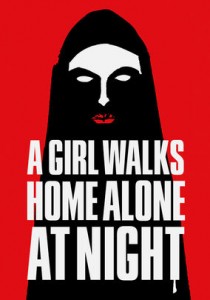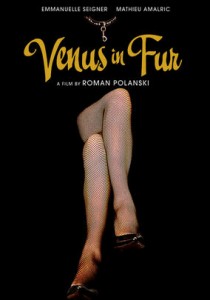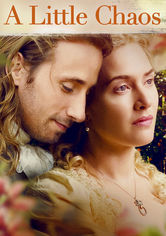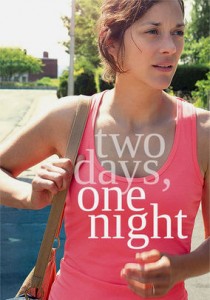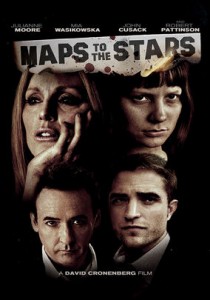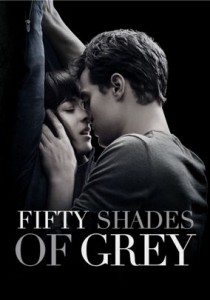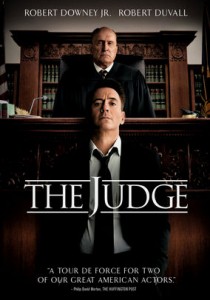A Girl Walks Home Alone At Night-2014
Director Ana Lily Amirpour
Starring Sheila Vand
Scott’s Review #271
Reviewed August 24, 2015
Grade: A-
A Girl Walks Home Alone At Night is a highly creative, unique, independent horror film from 2014.
One of the many reasons I am a fan of independent cinema is to discover and promote little-seen gems.
The dialogue is in Persian and the cinematography is in black and white, which is unique in modern film. I notice similarities between this film and Let the Right One In, 2008, (both the English and the Swedish versions) in the frigid mood and love story enveloped within.
This film is the debut of director Ana Lily Amirpour and what a marvel she could become. Despite obvious influences by other directors, A Girl Walks Home At Night has a brilliant freshness and seems original and unpredictable.
The title accurately depicts the main story. A teenage girl (Sheila Vand) walks around the dark streets of a city aptly named Bad City in the Iranian underworld.
The film is shot in southern California and could double for Detroit.
The girl, who has no name, has strange encounters with a myriad of peculiar individuals, including what appears to be a transgender prostitute, a vicious drug dealer, a nice yet mysterious young man named Arash, Arash’s father, who is hooked on drugs, and a mysterious cat.
She then embarks on a tender flirtation with Arash.
The overall plot, which I found secondary to the look of the film, centers around The Girl’s encounters with these individuals and their encounters and relationships with each other.
The Girl is a lonely vampire and feels isolated from society, but it is unclear what she is looking for. She is both destructive and sweet depending on the circumstance.
She takes her aggression out on the bad.
The most striking and impressive aspect is its dark moody atmosphere. Brooding and cold-looking, the city reeks of death and loneliness. The Girl speaks very little so her expressions are what the viewer will notice.
Her eyes delve into her soul.
She is the most interesting of the characters, but the others, specifically Arash and the transgender prostitute have potential and we are curious to explore more about them.
Arash and his father have more depth than any of the supporting characters- Arash painfully lets his drug-riddled father stay with him and attempts to assist him with his issues.
One assumes that since the father’s wife (Arash’s mother) has died suddenly, he has taken a downward spiral, but this is only suggested to the audience.
We do know for sure where she is- in one scene we see the father angrily look at a photo of a middle-aged woman and is destroyed by her absence. He believes that the woman has taken on the body of the mysterious cat.
Arash caring for his father is a fascinating role reversal.
Wouldn’t we expect the young man to have a drug problem and the father the caregiver? This is interesting in itself.
The influences are plentiful, but most notable from a director standpoint is David Lynch. The black and white filming along with the viewer’s point of view in one scene involving a car driving down a dark highway resembles the Lynch film Lost Highway (1997).
The moody background music and the slow but methodical pacing give A Girl Walks Home Alone At Night a Lynch feel. One curious element is The Girl’s interest in 1980′ pop music- her bedroom wall riddled with Madonna and similar pop stars from the 1980’s posters.
The Girl even admits to listening to a sappy Lionel Richie tune.
It is unknown if it even could BE the 1980’s as time seems unimportant. The film strangely combines edgy, alternative filmmaking with commercial pop references.
I half expected The Girl to break into a rendition of “Pour Some Sugar On Me”.
My thought is that perhaps Amir intends to portray the Girl’s desire to fit into mainstream society knowing that a vampire never can. This theory is proven when The Girl is melancholy when Arash buys her a hamburger, knowing she cannot enjoy it as he does.
Creative, with a dreary atmosphere, and intelligently thought out, A Girl Walks Home Alone At Night (2014) is a strange, murky experience in film experimentation.
Amirpour is a fresh, new director worth watching for.
Independent Spirit Award Nominations: Best First Feature, Best Cinematography
